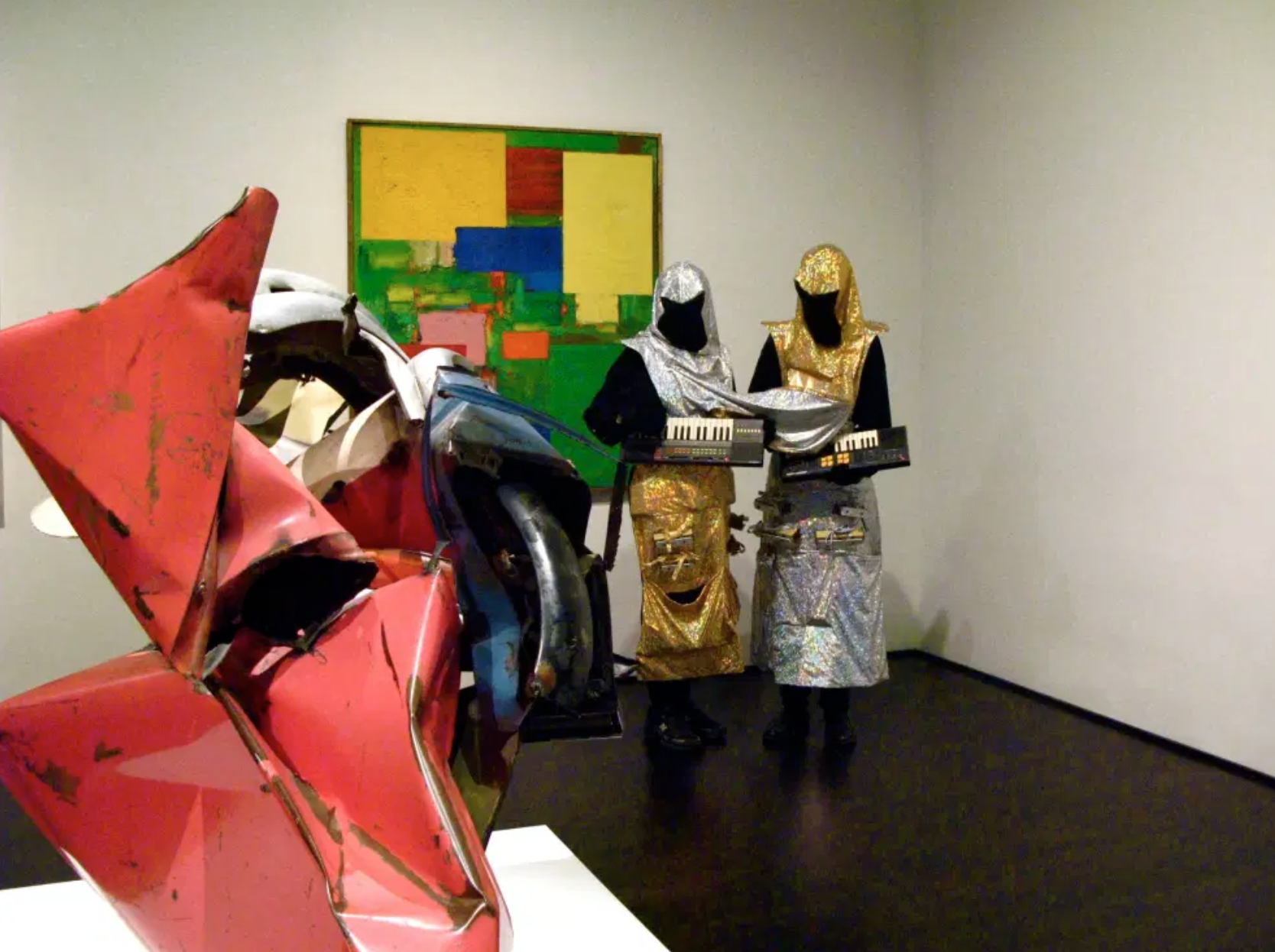“Wake Up Call: Machine Project’s Field Guide To LACMA,” co-written with Molly Rodgveller, Artillery Magazine, Vol. 3 Issue 3 (Jan. / Feb. 2009): 22, 27.
“Wake Up Call: Machine Project’s Field Guide To LACMA,” co-written with Molly Rodgveller, Artillery Magazine, Vol. 3 Issue 3 (Jan. / Feb. 2009): 22, 27.
It’s generally understood that encyclopedic museums are conservative by nature, demanding hands-to-yourself politeness from their visitors. Like an unmanageable grandparent shuffled off to a nursing home, once-shocking works of art are cloistered away in these institutions, protected by well-meaning, but overly cautious, curatorial wards.LA non-profit, Machine Projects, under the direction of the fearless Mark Allen, attempted to relieve this malady, if only temporarily, on November 15, 2008 with their Field Guide to the LA County Museum of Art. Like an L-Dopa freebase trip, Machine Project’s daylong takeover of the largest museum West of the Mississip effectively awakened LACMA’s most predictably dry galleries from their catatonic slumber.

We were a little wary of this ambitious project when we picked up the printed program for the day. This guide, intended to help viewers find each project, was an object lesson in frustrating design. After standing where four projects were supposed to be, without successfully finding any of them, we threw a foot-stomping tantrum and abandoned the confounding field guide, choosing unassisted perambulation instead.
Once inside the museum, boredom was a physiological impossibility. After arbitrarily choosing the third floor of the Ahmanson building, we found ourselves in front of Holly Vesecky and Josh Beckman’s immense reproduction of Sam Francis’ painting “Towards Disappearance,” remade entirely of fresh cut flowers, which perfumed four galleries like some sort of Cleopatrean dream.
We were awoken by chicken coop chatter, which we followed into the next gallery. There, under some of the finest examples Pollock penis Ab-Ex splatters, was a menagerie of hatted middle-agers from the Institute for Figuring. They were at work, teaching visitors how to crochet hyperbolic planes out of used plastic bags. In the corner of the same room, a pair of Siamese minstrel twins from the future, known only as ing, dressed in holographic cowls, quietly fingered diminutive keyboards and other mellifluous accouterments, which dangled from their glimmering utility aprons. Their infectious weirdness resurrected nearby art from the dead and thus John Chamberlain’s forty-six year-old mangled car shards became part of the alien terrain.
We were quickly lured, like Odysseus to the Sirens, into a room covered in Christ containing a barefoot folk singing duo. Emily Lacy and Daniel Brummel swayed as they sang in front of Gerrit Van Honthorst’s 1617 painting of potato-faced nonbelievers crowning Jesus with a thorn halo. The lyrics: “I’m alone in this world. I have no father in this world.” teased out meanings dormant for far too long.
The Doppleresque thump-atump-um-tump of a pounding drum kit in the elevator was inescapable. We took this hardcore people mover downstairs and when the doors opened we nearly fell headfirst into an apparition. We watched, slack jawed, as a Bulgarian vocal trio, punctuated by a woman of Amazonian proportions dressed in white, ululated some cousin of a yodel, while a banjo played beside her. The sounds echoed endlessly in the building’s cavernous main hall. It was time for some fresh air.

We strolled under the Broad Contemporary Art building (which was surprisingly lacking in Machine Project interventions), and found ourselves surrounded by visitor-made papier mâché vitrines. Liz Glynn, along with some volunteers, were transforming LACMA’s paper garbage, including some old budgets, into replicas of the museum’s Greco-roman vases. Opting to keep our hands clean, we dodged several visitor-made robots on our way to a small hand written cardboard sign, reading “TOUR.”
“So I guess this is all of us,” chirped Annie O’Malley as she began to guide our group of three on a tour titled “LACMA During the Pleistocene Epoch.” Annie described the landscape as it might have looked over 11,000 years ago, complete with mammoths and tar pits, and brought us up to date on the museum’s battles over land ownership and artifact provenance. We returned to Machine’s Mission Control center at the British Petroleum Grand Entrance, with fossil fuel on our minds.
Suddenly, all heads tilted towards the museum roof as either Mark Richards or Alexy Yeghikian (it was hard to tell which one) stood nonchalant under a replica of a gothic arch surrounded in machine-made fog. Then, like a banshee scream, the guitarist totally ripped the skyline a new one. It was an elating, head banging, sign-of-the-Devil experience. After one minute, it was over. This happened every-hour-on the hour, all day long.

And that’s the way it went. Surprises announced themselves at every turn. The helmet-clad folks from Fallen Fruit led tours of the citrus flora hidden in the museum’s collections, Adam Overton dispensed massages with musical accompaniment, and hairstylists, aided by ambient music, cut hair for free. The lesson learned from the day’s events was clear: As we charge headlong into increasingly difficult times, events like this one, that promote curiosity in the face of uncertainty and cultivate creativity from meager means, are more critically necessary than ever. We left LACMA exclaiming aloud to the art gods, “Give Mark Allen the MacArthur Genius Prize Already!”
©2024 Tucker Neel. All rights reserved.